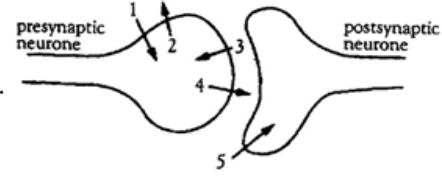
The diagram shows the sequence of events occurring as an action potential arrives at a synapse. What are the substances moving across the membranes?

1 2 3 4 5 A. K+ Na+ Ach Ca2+ K+ B. K+ Na+ K+ Ca2+ Ach C. Na+ K+ Ca2+ Ach Na+ D. Na+ K+ Na+ Ach Ca2+

| 1 | 2 | 3 | 4 | 5 | |
| A. | K+ | Na+ | Ach | Ca2+ | K+ |
| B. | K+ | Na+ | K+ | Ca2+ | Ach |
| C. | Na+ | K+ | Ca2+ | Ach | Na+ |
| D. | Na+ | K+ | Na+ | Ach | Ca2+ |
Answer
342.6k+ views
Hint:
The functional and structural units of the nervous system are known as neurons. Generally, neurons are known as nerve cells. It transmits information in the form of electrical impulses.
Complete answer:
Neurons communicate with each other at junctions which are known as synapses. One neuron sends a message to a target neuron of another cell with the help of a synapse. Electrical and chemical synapses are two types of synapses. The electrical synapse communicates with the help of a chemical messenger while in the electrical synapse ions flow directly between cells.
At the chemical synapse, an action potential or nerve impulse activates the presynaptic neuron to release neurotransmitters. The pre-synaptic membrane is depolarised due to the entry of sodium ions (1) as the action potential reaches the synapse. With the exit of potassium ions (2) the membrane is subsequently repolarised. The arrival of the action potential causes calcium channels in the membrane to open, thus calcium ions rush into the synaptic knob (3). This causes the synaptic vesicles to fuse with the pre-synaptic membrane, releasing acetylcholine into the synaptic cleft (4). On the postsynaptic membrane, acetylcholine binds to specific receptor sites, opening ion channels and causing sodium ions to enter (5), depolarising the membrane.
Hence the correct answer is 1. Na+ 2. K+ 3. Ca2+ 4. Ach+ 5. Na+..
Option ‘C’ is correct
Note:
Electric synapse can conduct the nerve impulses faster than the chemical synapse.
The functional and structural units of the nervous system are known as neurons. Generally, neurons are known as nerve cells. It transmits information in the form of electrical impulses.
Complete answer:
Neurons communicate with each other at junctions which are known as synapses. One neuron sends a message to a target neuron of another cell with the help of a synapse. Electrical and chemical synapses are two types of synapses. The electrical synapse communicates with the help of a chemical messenger while in the electrical synapse ions flow directly between cells.
At the chemical synapse, an action potential or nerve impulse activates the presynaptic neuron to release neurotransmitters. The pre-synaptic membrane is depolarised due to the entry of sodium ions (1) as the action potential reaches the synapse. With the exit of potassium ions (2) the membrane is subsequently repolarised. The arrival of the action potential causes calcium channels in the membrane to open, thus calcium ions rush into the synaptic knob (3). This causes the synaptic vesicles to fuse with the pre-synaptic membrane, releasing acetylcholine into the synaptic cleft (4). On the postsynaptic membrane, acetylcholine binds to specific receptor sites, opening ion channels and causing sodium ions to enter (5), depolarising the membrane.
Hence the correct answer is 1. Na+ 2. K+ 3. Ca2+ 4. Ach+ 5. Na+..
Option ‘C’ is correct
Note:
Electric synapse can conduct the nerve impulses faster than the chemical synapse.
Recently Updated Pages
What is glandular epithelium class 11 biology NEET_UG

The common characteristics between tomato and potato class 11 biology NEET_UG

Why are manures considered better than fertilizers class 11 biology CBSE

Find the coordinates of the midpoint of the line segment class 11 maths CBSE

Distinguish between static friction limiting friction class 11 physics CBSE

The Chairman of the constituent Assembly was A Jawaharlal class 11 social science CBSE

Trending doubts
What is BLO What is the full form of BLO class 8 social science CBSE

What is meant by exothermic and endothermic reactions class 11 chemistry CBSE

Which places in India experience sunrise first and class 9 social science CBSE

What are the major means of transport Explain each class 12 social science CBSE

Which are the Top 10 Largest Countries of the World?

Fill the blanks with the suitable prepositions 1 The class 9 english CBSE




